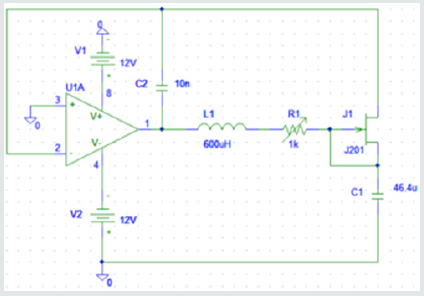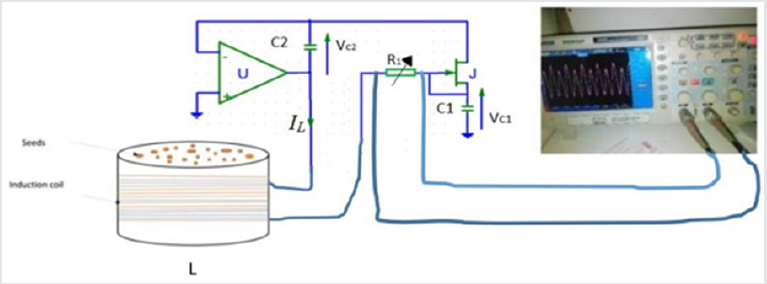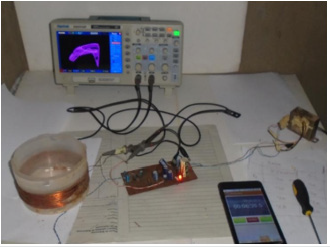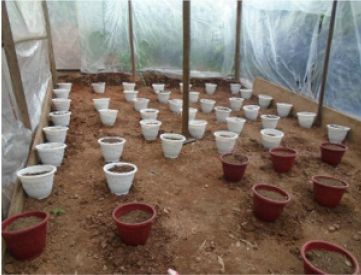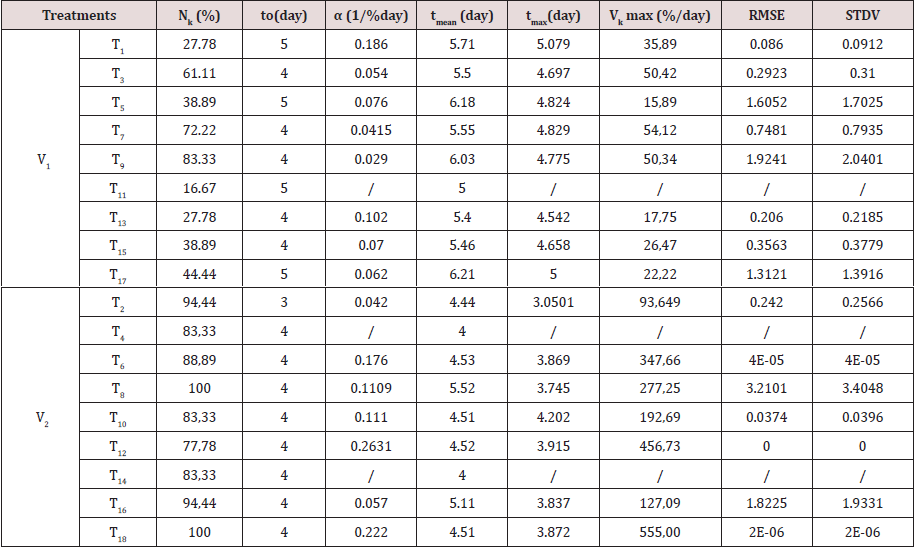
Lupine Publishers Group
Lupine Publishers
Menu
ISSN: 2641-6794
Research Article2641-6794 
Logistic Curve Modeling of the Germination of Beans Seeds (Phaseolus Vulgaris) Previously Exposed to Multi-Periodic and Chaotic Electromagnetic Fields Volume 5 - Issue 4
Noula Moungang T1, Tchitnga R1,2*, Kouam E B3 and Fomethe A1
- 1Department of Physics, University of Dschang, Cameroon
- 2Institute of Surface Chemistry and Catalysis, Albert-Einstein-Allee 47, Germany
- 3Department of Crop Sciences, University of Dschang, Cameroon
Received: July 27, 2020; Published: August 18, 2020
Corresponding author:Tchitnga R, Department of Physics, University of Dschang, Cameroon
DOI: 10.32474/OAJESS.2020.05.000218
Abstract
The objective of this study was to determine whether the kinetics of germination of seeds stimulated by multi- periodic and chaotic electromagnetic fields could be described using the modified Malthus-Verhulst equation. The electrical circuits used for magnetization could generate signals of period 1, -2, and -4 as well as chaotic ones. The study was carried out on two varieties of beans (V1 and V2) whose seeds were stimulated for 3 and 5 minutes respectively with electromagnetic fields of periodic properties mentioned above. A group of unexposed seeds served as the control for comparative analysis. The curves were plotted for the experimental data by minimizing the square sum of the differences between the experimental data and the mathematical model. We found that the experimental data fit well with the model, but only on the condition that all the seeds submitted to the same experimental treatment do not emerge at the same time. Analysis of variance (ANOVA) showed a significant difference in germination rates as well as the difference in lengths for various treatments (P < 0.05). The conclusion that the effect of electromagnetic signals on the development of these plants depends both on the variety of seeds and the duration of stimulation, as well as on the periodicity of the signal could be drawn.
Keywords: Modeling; Malthus-Verhulst equation; Multi-periodic electromagnetic field; Chaotic electromagnetic field; Logistic curve; Seeds stimulation; Seeds germination; Plant growth
Introduction
Plants play an essential role in the fragile balance of our planet. They are regenerators of oxygen and sources of energy (agro fuels). Among other roles they play, they are mainly the basis of food for many other living species and mankind. Plants or their derivatives are used in architectural constructions or clothing, they are the source of many drugs; we depend entirely on the plant’s world for our survival [1]. Human beings sometimes exert strong pressure on the environment to optimize the yield of certain crops, mainly with the help of chemicals such as fertilizers or pesticides. Although these contributions can sometimes prove to be useful or even necessary, their impact on the ecosystem, on a small or large scale, is not always well understood [2]. The use of chemicals, which is the most widely used method of crop protection is also the least environmentally friendly. It leads to a food imbalance, the poisoning of direct manipulators and their relatives, the destruction of the ecosystem, the pollution of the groundwater, and to the acceleration of the greenhouse [3].
Modern agricultural techniques seek safe methods to increase the quality of agricultural yields using an interdisciplinary combination of mathematics, biophysics, agronomy, molecular and physical biology [4]. The value of sowable material considerably depends on substances that are used in plant protection for seed dressing. The main objective of the integrated protection system is the application of alternative, biological substances instead of chemical ones [5]. It is beneficial both for the plants’ form and their yield as well as for biodiversity of soil environment [6]. A magnetic field (MF) is an inescapable environmental factor for plants on the Earth. During the evolution process, all living organisms experienced the action of the Earth’s MF (geomagnetic, GMF), which is a natural component of their environment [7].
The first documented work on the effect of the magnetic field on biological organisms is the publication of Reinke [8] which presents the results of experiments concerning the effect of the magnetic field on the development of plants. The documented work Tolomei [9] shows the effect of faster germination of plants in a magnetic field. It was the first study demonstrating the effect of magneto tropism, a phenomenon discovered by Tolomei, which was then further studied by Audus [10]. An in-depth discussion of the experimental and theoretical foundations of the effect of the electromagnetic field on various biological structures - from cells to whole organisms was published in two volumes in the years 1900-1901 [11]. Classical and historical works, including a 1903 publication Ewart [12] emphasize that in aquatic plants placed in the magnetic field, the movement of the cytoplasm ceases if the lines of the magnetic field are perpendicular to the direction of movement, while a parallel field does not produce this effect. It has been observed that the magnetic field accelerates the growth of plant roots and increases the permeability of the cell membrane [13]. This observation allowed the author to successfully grow wheat germs that were 100% longer than the average.
Krylov and Tarakonova [14] were among the first to report on the effects of the magnetic field on seeds prior to germination [7]. They proposed an auxin-like effect of MF on germinating seeds, calling this effect magnetotropism. The auxin-type effect of MF has also been suggested to explain the ripening of tomato fruits [15]. There has been evidence that the root growth response is not directly heliotrope but rather magneto tropic or geomagnetotropic. Observation of the roots of a number of other plants suggested that some inherent factors within a species or even within a variety of a species could also be necessary before the tropism became manifest [16].
Good seed germination is essential for better crop yield
[3]. In this regard, many researchers have demonstrated that
exposing seeds to static magnetic fields before sowing them is an
inexpensive physical method of increasing seed germination and
the growth of young plants Carbonell & Podlesny [2,17] because
this process increases the concentration of ions, free radicals and
electrical elements without any degradation/alteration of the
plant. This technique improves the chemical profile of the seed,
makes it fresher physically, makes the membrane more permeable,
and promotes the free circulation of active ions of the metabolic
pathways by increasing the biochemical and physiological feedback
[18].
To stimulate seeds prior to sowing, some authors have subjected
the seeds of various cash crops to different values of static magnetic
fields for different durations [19]. Other authors have repeated
the same processes as before but with sinusoidal electromagnetic
fields of various frequencies [20]. The presowing stimulation of
seeds with a variable electromagnetic field may involve specially
designed electromagnets [21]. Furthermore, it has been recently
proven that multi-periodic and chaotic electromagnetic fields can
have effects on the evolution of bean plants, from germination to
harvest [22].
These authors used an electronic circuit of a few components
Tchitnga [23] out of a family of simple chaotic circuits comprising
a coil Tchitnga Talla & Zebaze Nanfa’a [24-26] to generate
electromagnetic signals of various periods (period-1, period-2,
period-4) as well as a chaotic signal. These various signals were
applied to the bean plants during their evolution 24 hours a day
and 7 days a week. The results proved that the signals of period-2
were harmful to germination and growth. However, plants subject
to this signal had the lowest pod loss rate compared to all other
treatments. The treatments subjected to period-4 had substantially
the same behavior during their evolution as those subjected to
chaotic signals. This last treatment is the one that formed the
largest number of pods. It is also the one that experienced the
highest rate of pod loss during the ripening phase. The period-4
treatment experienced a production time gain of approximately 10
days compared to the reference plants used as control. In this recent
work, the authors did not take into account the costs of energy
consumed by their system during the duration of the experiment as
well as the difficulties of implementation in supermarkets.
In the present work, we study the effects on germination and
growth of two varieties of Phaseolus Vulgaris using the same system
to stimulate their seeds before they are planted. Indeed, we study
the effects of chaotic electromagnetic fields and of various periods
(1, 2, and 4) on the germination and the beginning of the growth
of two varieties of the common bean whose seeds were stimulated
by these electromagnetic signals during 3 and 5 minutes. The
reformulated Malthus-Verhulst logistic equation is used to model
the germination kinetics and adjust the experimental data and then
determine the growth parameters.
To analyze the germination of seeds from various plants,
several mathematical formulas have been proposed [27]. The mean
germination time (MGT) is evaluated by equation (1) proposed by
Haberlandt in the 19th century Ranal and Santana [28] as follows:
 (1)
(1)where: ti is the time from the start of the experiment to the i-th observation (day or hour), ni is the number of seeds germinated corresponding to the i-th observation, and tk is the last recorded time of germination corresponding to k-th observation. The idea of the coefficient of velocity (CV) was introduced by Kotowski in the 20th century Ranal and Santana [27]. The formula for the coefficient of velocity is Sikder [28],
 (2)
(2)where: n1, n2,..., nx are the number of seedlings counted on the first day, second day, and so on until the last day (x) and t1, t2,..., tx are the number of days between sowing and the first collection, second collection, and so on. Accordingly, the mean germination rate is defined as:
 (3)
(3)The kinetics of germination of seeds stimulated by a magnetic or electric field before sowing is most often described using the Malthus-Verhulst equation Pietruszewski, Pietruszewski and Kania, Pietruszewki and Martinez [30-33], which we will use also in the present case of seeds stimulated with electromagnetic field:
 (4)
(4)Here, N(t) represents the number of germinated seeds in time t, Nk is the final number of germinated seeds,
α corresponds to the germination speed coefficient, while t0 is the time of germination of the first seed.
On the basis of the logistic curve, the germination speed was also specified as
 (5)
(5)The logistic curve of the Malthus-Verhulst equation and the speed of germination effectively model the germination process of stimulated seeds [32].To obtain the maximum germination time corresponding to the maximum time of the germination speed of plants, Pietruszewski [30] advises to null the acceleration of its growth. Applying this technique in our case led us to determine the second derivative of equation (5):
 (6)
(6)Solving equation (6) equal to zero, we obtained
 (7)
(7)However, Mahajan and Pandey [20] have estimated that the previous logistic equations used for the modeling of germination are experimentally limited because it is difficult to find the instant when the first seed of a treatment actually germinated. These authors considered that it was easier to find a time t0 when a certain number of Ni seeds would have germinated. Thus, they suggested the reformulation of the Malthus-Verhulst equation as follows:
 (8)
(8)where Ni is the number of seeds sprouted at time t = t0.
The germination speed obtained in this case by derivating equation (8) as a function of time becomes:
 (9)
(9)It is to be noted that equations (5) and (9) are equivalent and therefore have the same derivative. The maximum germination time of the reformulated equation of Malthus-Verhulst becomes:
 (10)
(10)which is slightly different from the previous equation (7)
Material and Methods
Experimental Procedures
Seeds: Two varieties of seeds were obtained from the Faculty
of Agricultural Sciences at the University of Dschang. Uniform and
healthy seeds were manually selected, counted, and divided into
five groups by variety.
The climatic conditions were recorded from the weather station
of the city of Dschang, Cameroon. The mean values of temperature,
relative humidity, sunshine, atmospheric pressure, and wind speed
were 24.32 °C, 85.68%, 4.64 h, 97.3 KPa and 1.34 m/s, respectively.
Electromagnetic Field Treatment
The electromagnetic seeds stimulation signals were obtained from the very stable circuit of (Figure 1) Tchitnga [23], which is able to generate electromagnetic signals of period-1, -2, and -4 respectively, as well as chaotic waves.
For the experiment, we realized the coil L1 by wounding a
0.75 mm diameter copper wire around a cylindrical plastic box of
dimensions 13 cm in diameter and 8 cm high. The inductance of
approximately 600 μH was obtained by performing 54 windings.
The entire circuit was powered by a balanced ±12 V power supply
and the signal that could be displayed on a digital oscilloscope is
shown in (Figure 2) below.
The bean was chosen for its short ripening time and its large
size, useful for visual observation without the need for optic
instrumentation. Plants in the form of seeds were sown in plastic
jars for a period of two months. The same soil was used for all plants,
and the same amount of water was used for regular watering for all
plants. In addition, the plants were all placed in the same area for
development to ensure minimal environmental polarization in the
results. They were all constantly kept under the same environmental
conditions (temperature, light, humidity). No fertilizers were added
to the plants during the entire experiment. Varying the resistance
R1 used as a control parameter for the electromagnetic waves we
could obtain different periods (1, 2, and 4), as well as the chaotic
signal depicted by (Figure 3). The figures opposite represent the
time evolution curves of the generated electromagnetic signals as
well as the phase portraits of those same waves Table 1.
Seeds Treatment
In order to evaluate the hypothesis of a possible effect of seeds’ pre-treatments (stimulation) with the signals of (Figures 3 & 4) on the evolution of plants, we submitted two varieties of bean seeds (Phaseolus Vulgaris) to these electromagnetic fields before sowing. Table 2 shows the different treatments to which the seeds were submitted for the experiment. Indeed, for each variety subdivided into five groups, the first, say T1 for V1 (respectively T2 for V2) was used as the reference and was not submitted to our produced electromagnetic field. Meanwhile, the remaining four were subjected to the electromagnetic signals, each for one particular periodic family for 3 and 5 minutes, respectively. For our analysis, a total of three hundred and twenty-four seeds were sown and distributed as follows:
Figure 3: (a - d) Time evolution of the signal and (e - h) the corresponding experimental phase portraits of the voltage signals at the source electrode of the JFET in Figure 1 with the oscilloscope scale (X: 10 V/Div, Y: 10 V/Div). (a and e: period 1; b and f: period 2; c and g: period 4; d and h: chaotic signal).
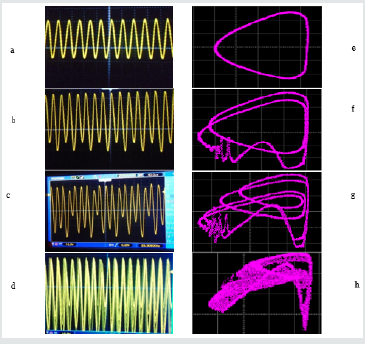
Each treatment was divided into three repetitions. After stimulation, the seeds were sown in an experimental field in a random manner. The electromagnetically treated seeds were sown according to the protocol of the International Seed Testing Association (ISTA). The growth parameters were observed and recorded every day until the end of the experiment. We were interested in germination which lasts eight days then the difference in length was evaluated.
Mathematical solving method
To analyze the germination behavior of bean seeds stimulated for 3 minutes and 5 minutes respectively with electromagnetic signals of period-1, -2, -4 and a chaotic one, we used equation (8) obtained by the application of the reformulated Malthus-Verhulst, to adjust the experimental data for each treatment (Table 3&4).
The germination rate N (t) at time t depends on the parameters Ni, Nk, α, and t0. However, the final germination rate Nk is obtained by calculation at the end of germination time by the formula:
 (11)
(11)As soon as the seeds were sown, observations were made every day until the end of the germination period. For each treatment, the first day (t0) of the beginning of germination was noted as well as the number of seeds (Ni) having germinated at that time. The only remaining parameter to be determined is α. The germination modeling equation being non-linear, we used a numerical resolution method to determine this parameter. The least-squares method was retained for the resolution algorithm and was programmed by the Gauss-Newton method in Matlab 2018. It was also necessary to verify that the germination dynamics of the different treatments could be adjusted by equation (8). Once seeds were sown, the plant was observed daily, and the germination parameters noted each day at the same time.
The error of a model must be evaluated according to two traits, namely the deviation and the precision. The first refers to the deviation of the mean of the model errors from zero (standard deviation: STDV), while the other refers to the extent of the model errors. Obviously, the two traits must be analyzed to assess the effectiveness of the model. Error and precision can be assessed using statistical estimators. The accuracy of the model was evaluated on the basis of the Root Mean Square Prediction Error (RMSE) determined on the basis of a work by Gauch [34].

Here n = 8 stands for the number of measurement points (1 readout/day during 8 days), Ni exp and Nitheor are respectively the measured and calculated values of the emergence percentage within the i-th time instant (ti = {1, 2,. . ., 8} days), and Nk is the maximum value of the germination percentage in the investigated period.
Results
Germination analysis
Figures 5 and 6 show the germination curves of different treatments for each of the two varieties. It can be noted that the experimental data fit perfectly theoretical curves. The control treatment of variety 1 obtained a very low germination rate. Table 5 shows that there was a significant difference in germination between certain treatments of this variety. Thus, the stimulation of seeds prior to seedling changes the germination rate.
Variety 1 Treatments
V1 Treatments T1, T3, T5, T7, T9, T11, T13, T15 and T17 had germination rates of 27.78 %, 61.11 %, 38.89 %, 72.22 %, 83.33%, 16.67 %, 27.78 %, 38.89 % and 44.44 %, respectively. Thus, compared to the control (T1), germination rates were observed to increase by 33.33 %, 11.11 %, 44.44 %, 55.55%, - 11.11 %, 0 %, 11.11 % and 16.66 % for T3, T5, T7, T9, T11, T13, T15 and T17 respectively. The T11 treatment had the lowest germination rate (Table 5).
Figure 6: Germination curves of Phaseolus Vulgaris seeds (V1) subjected to the multi-periodic and chaotic electromagnetic field of 3- and 5-minutes duration.
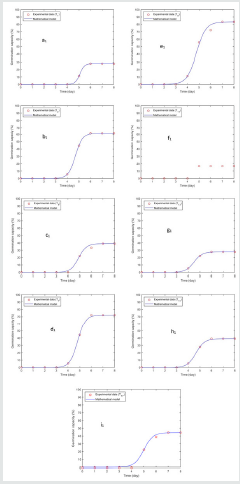
We found that stimulating seeds using period-4 electromagnetic signals for 3 minutes (T11) does not promote germination. A stimulation time of 5 minutes very slightly improves germination. All other treatments have better germination rates than the control treatment (Figure 6). All the plants of the three repetitions of T11 treatment emerged on the same day. This makes impossible any adjustment between the theoretical and the experimental data (Figure 6.f1).
Variety 2 Treatments
V2 Treatments T2, T4, T6, T8, T10, T12, T14, T16 and T18 had germination rates of 94.44 %, 83.33 %, 88.89 %, 100 %, 83.33%, 77.78 %, 83.33 %, 94.44 % and 100 %, respectively. Thus, compared to the control (T2), germination rates were observed to increase by - 11.11 %, - 5.56 %, 5.56 %, - 11.11 %, - 16.66 %, - 11.11 %, 0 % and 5.56 % for T4, T6, T8, T10, T12, T14, T16 and T18, respectively.
The observation at the experiment’s site showed that all the plants of the three repetitions of T4 and T14 treatment germinated on the same day, making any adjustment between the theoretical and the experimental data impossible (Figure 7.b2 and Figure 7.g2).
Figure 7: Germination curves of Phaseolus Vulgaris seeds (V2) subjected to the multi-periodic and chaotic electromagnetic field of 3- and 5-minutes duration.

The observation at the experiment’s site showed that all the plants of the three repetitions of T4 and T14 treatment germinated on the same day, making any adjustment between the theoretical and the experimental data impossible (Figure 7.b2 and Figure 7.g2).
Influence of stimulation time on both varieties
The analysis of variance showed us significant differences between certain treatments at 5% (between T1 and T9, T7 and T11, T9 and T13, T8 and T12, T12 and T18) and at 1% (between T9 and T11).
Table 5 depicts the calculated values of different parameters. It can be noted that when t0 = tmean, it is not possible to adjust the experimental values to the theoretical ones and therefore, the parameter cannot be calculated. This curve (Figures 8 & 9) shows the germination rate of the control treatment of variety 1, which is 27.72%. We note that when the seeds are stimulated with the electromagnetic fields of period-1, period-2, period-4, and chaotic waves for durations of 3 and 5 minutes respectively, the germination rate of the treatment subjected to period-2 is the most favorable. It increases continuously with the stimulation time, however more rapidly by the stimulation’s duration of 3 min that of 5. Period-1 makes it possible to obtain a germination rate for a stimulation time of 3 min, greater than that of the control treatment. However, this rate decreases when the stimulation time is prolonged to 5 min but still remains slightly higher than that of the control treatment. Period 4 slows down the germination rate when the stimulation’s time is of 3 min, to a value below that of the control. Above that duration of 3 minutes, Period 4 also allows a slight increase in the germination rate with the stimulation time, to reach that of the control for 5 min of stimulation.
The stimulation with the chaotic field also shows a continuous increase in the germination rate for both durations of 3 and of 5 minutes. In this last case, the germination growth rate is even greater after 3 minutes of stimulation.
The germination rate of the control treatment of V2 was 94.44%. A3 minutes stimulation prior to seedling using Period-2 waves led to a germination rate of 100%. This rate drops to 83.33% if the stimulation lasts 5 minutes, which means less than the germination rate of the control. Stimulation under Period 1 decreases the rate of germination which can be improved by increasing the stimulation time. For both durations, however, the germination rate remains below that of the control. Period 4 has an influence similar to Period 1 but more unfavorable to germination than the latter. The chaotic signal brings a slight improvement in the germination rate which increases with stimulation time, just like in the case of V1. It can be noted that the effects of seed stimulation by chaotic and Period-4 electromagnetic fields do not depend on the varieties of bean chosen. On the other hand, the behavior of periods-1 and -2 are slightly different depending on the variety stimulated.
Conclusion
The experimental data fit well with the Malthus-Verhulst equation modified by Mahajan and Pandey [20]. However, we note that this modified equation can only be applied to model the dynamics of germination if the number of seeds (Ni) having germinated at the initial time (t0) of the first observation is different from that of the final germination date. In other words, the average germination time would have to be different from t0 for this equation to model the germination curve. It is obvious that the probability of getting this critical case decreases when the number of subjects for treatment increases. In this work, we did not take into account the quality of the soil used but we can suggest in view of the results obtained with the two varieties of beans, that the type of electromagnetic signal does indeed modify the growth parameters of the plants. The treatment subjected to the chaotic electromagnetic field has a germination rate which increases very slightly with the stimulation time. Period 2 presented by Noula [21]as being very harmful to the entire growth phases of bean plants when they are continuously subjected to this electromagnetic effect, seems rather to be beneficial at least for the germination phase when the seeds are stimulated before seeding. The selection of good quality seeds is a major issue in agriculture because a good yield begins with good germination. Several seed-treatment techniques are in force and the most widely used is chemical treatment. However, some palliative chemical methods benefit more, like biological treatments that use extracts from other plants. But these extraction techniques are very slow and energy intensive. They are more used for the conservation of seeds but are very germicidal. Among the various combinations of electromagnetic signals and exposure time, period 2 for 5 min gave the best results for variety 1. This improvement in the germination rate suggests that the seeds of Phaseolus Vulgaris treated electromagnetically can be used practically in agriculture, where environmental factors limit seed germination. This study allowed us to establish the basics of seed pre-treatment with multiperiodic and chaotic electromagnetic waves as a technique to improve germination, and therefore the yield of cash crops.
Through this analysis, we are also moving from the traditional used of chaotic electrical circuits like in secure telecommunication Kengne [34,35], of random and pseudo-random bits generation for GPS and games programming Nguimdo [36], of mechanical applications Nana & Mbou Soh [37-39], to embrace that of agriculture Noula [40] and of bio-mimetism in nature [41,42].
References
- Charlotte Baey (2014) Modélisation de la variabilité inter-individuelle dans les modèles de croissance de plantes et sélection de modèles pour la pré Mathématiques générales [math.GM]. Ecole Centrale Paris. Français. NNT : 2014ECAP0024.
- Podleśny J, Pietruszewski S, Podleśna A (2004) Effciency of magnetic biostimulation of broad bean cultivated in experimental plot conditions. Int Agrophysics 18: 65-71.
- Munawar Iqbal, Dil Muhammad, Zia-ul-Haq and Yasir Jamil, M. and Raza Ahmad (2012) Effect of Presowing magnetic field Treatment to Garden Pea (pisum sativum l) seed on Germinationand Seedling Growth Pak J Bot 44(6); 1851-1856.
- Cieśla A, Kraszewski W, Skowron , Syrek PM (2015) Wpływ działania pola magnetycznego na kiełkowanie nasion. Przegląd Elektrotechniczny 91(1): 125-128.
- Szparaga A, Czerwińska E (2017) Modelling of beetroot seedlings with modified generalized logistic functions. Journal of Research and Applications in Agricultural Engineering 61(3): 67-71.
- Brachaczek A, Kaczmarek J, Kosiada T, Jędryczka M (2012) Występowanie suchej zgnilizny kapustnych na wybranych odmianach rzepaku ozimego i ich plon w warunkach doświadczeń łanowych w Wielkopolsce Rośliny Oleiste, XXXIII, 56-72.
- Maffei ME (2014) Magnetic field effects on plant growth, development, and evolution. Front. Plant Sci 5: 445.
- Reinke J (1876) Untersuchungen der Wachstrum. Botan. Ztg 34,129. In: Biological Effect on Magnetic Fields (Eds.), Barnothy MF Plenum Press 1: 183-195.
- Tolomei G (1893) Anzione del magnetismo sulla germinazione. Malpighia, 7, 470. In: Biological Effect on Magnetic Fields (Ed. M.F. Barnothy). Plenum Press 1: 183-195.
- Audus LJ (1960) Magnetotropism: A new plant growth response. Nature 185: 132-134.
- Danilewski WJ (1901) Studies on the influence of electricity on physiology of plants (in Polish). In: Electromagnetic felds and living nature (Eds.), Presman AS, PWN, Warsaw, Poland.
- Eward A (1903) On the physics and physiology of protoplasmatic streaming in plants. In: Electromagnetic Fields and Living Nature (in Polish) Presman AS, 1971, PWN, Warsaw, Poland.
- Sawostin PW (1930) Magnetic growth reaction in plants. Planta 12: 327-333.
- Krylov A, Tarakonova GA (1960) Plant physiology. Fiziol Rost 7: 156.
- Boe AA, Salunkhe DK (1963) Effects of magnetic fields on tomato ripening. Nature 199: 91–92.
- Pittman UJ (1962) Growth reaction and magnetotropism in roots of winter wheat (Kharkov 22 MC). Can J Plant Sci (42):430.
- Carbonell MV, Martinez E, Amaya JM (2000) Stimulation of germination in rice (Oryza Sativa L.) by a static magnetic field, Electro- and Magnetobiology 19(1): 121–128.
- Munawar Iqbal, Zia ul Haq, Yasir Jamil and Jan Nisar (2016) Pre-sowing seed magnetic field treatment influence on germination, seedling growth and enzymatic activities of melon (Cucumis melo L.) Biocatalysis and Agricultural Biotechnology 6: 176–183.
- Hirota N, Nakagawa J, Kitazawa K (1999) Effects of a magnetic field on the germination of Journal of Applied Physics 85(8): 5717–5719.
- Zepeda-Bautista R, Hernandez-Aguilar C, Suazo-Lopez F, Dominguez-Pachecco AF,Virgen-Varas J, and et al., (2014). Electromagnetic field in corn grain production and health. African J Biotechnol 13(1): 76-83.
- Mahajan TS, Pandey OP (2011) Reformulation of Malthus-Verhulst equation for black gram seeds pretreated with magnetic field. Int Agrophys 25: 355-359.
- Noula Moungang T,Tchitnga R, Nguazon Tekou, Fomethe A (2019) Effect of multi-periodic and chaotic magnetic fields on plants’ growth from germination to harvest: experiment on bean (phaseolus vulgaris). European Agrophysical Journal 6(3): 30 - 45.
- Tchitnga R, Nguazon T, Louodop Fotso PH, Gallas JAC (2016) Chaos in a Single Op-Amp–Based Jerk Circuit: Experiments and Simulations. IEEE Trans Circ and Syst-II: Express Briefs 63(3): 239-243.
- Tchitnga R, Fotsin HB, Nana B, Louodop Fotso PH, Woafo P (2012) Hartley’s oscillator: the simplest chaotic two-component circuit. Chaos, Solitons & Fractals 45(3): 306-313.
- Talla FC, Tchitnga R, Kengne R, Nana B, Fomethe A (2019) Didactic model of a simple driven microwave resonant T-L circuit for chaos, multistability and antimonotonicity. Heliyon 5(10): e02715.
- Zebaze Nanfa'a R, Tchitnga R, Louodop Fotso PH, Kengne R, Talla FC, and et al., (2020) Non periodic oscillations, bistability, coexistence of chaos and hyperchaos in the simplest resistorless Op-Amp based Colpitts oscillator. Heliyon 6(2): e03482.
- Szparaga A, Kocira S (2018) Generalized logistic functions in modelling emergence of Brassica napus L.. Plos one 13(8): e0201980.
- Ranal MA, Santana DG (2006) How and why to measure the germination process? Revista Brasil Bot 29(1): 1-11.
- Sikder S, Hasan MA, Hossain MS (2009) Germination characteristics and mobilization of seed reserves in maize varieties and influenced by temperature regimes. J Agric Rural Dev 7(1-2): 51-56.
- Pietruszewski S (2001) Modeling by logistic curve germination of wheat seeds Henika cultivar in magnetic field (in Polish). Acta Agrophysica 58: 143-151.
- Pietruszewski S (2002) Influence of magnetic Felds on seeds germination of selected cultivated plants (in Polish). Acta Sci Pol Technica Agraria 1(1): 75-81.
- Pietruszewski S, Kania K (2010) Effect of magnetic field on germination and yield of wheat. Int Agrophys 24: 275- 302.
- Pietruszewski S, Martínez E, (2015) Magnetic field as a method of improving the quality of sowing material: a review. Int Agrophys 29: 377-389.
- Gauch HGJr, Hwang GJT, Fick GW (2003) Model Evaluation by Comparison of Model-Based Predictions and Measured Values. Agron J 95:1442-1446.
- Kengne R, Tchitnga R, Mezatio A, Fomethe A, Litak G (2017) Finite-time synchronization of fractional-order simplest two-component chaotic oscillators: application to digital cryptography, European Physical Journal B Article ID 839038: 1-12.
- Kengne R, Tchitnga R, Mabekou S, Wafo Tekam BR, Soh GB and et al., (2018) On the relay coupling of three fractional-order oscillators with time-delay consideration: Global and cluster synchronizations, Chaos, Solitons & Fractals 111: 6-17.
- Nguimdo RM, Tchitnga R, Woafo P (2013) Dynamics of coupled simplest chaotic two-component electronic circuits and its potential application to random bit generation. CHAOS 23(4): 043122.
- Nana B, Yamgoué SB, Tchitnga R, Woafo P (2017) Dynamics of a pendulum driven by a DC motor and magnetically controlled, Chaos, Solitons & Fractals 104 (3):18-27.
- Nana B, Yamgoué SB, Tchitnga R, Woafo P (2018) On the modeling of the dynamics of electrical hair clippers, Chaos, Solitons & Fractals 112: 14-23.
- Soh Mbou G, Monkam YJ, Nwagoum PR, Tchitnga R, Woafo P (2020) Study of a piezoelectric plate based self- sustained electric and electromechanical oscillator. Mechanics Research Communications 105: 103504.
- Louodop P, Saha S, Tchitnga R, Muruganandam P, Dana SK, and et al., (2017) Coherent motion of chaotic attractors, Physical Review E 96: 042210.
- D’Astre AS (1882) Influence physiologique de l’etat magnitique, In: Biological Effect on Magnetic Fields (Eds.), Barnothy MF. Plenum Press Paris, France.

Top Editors
-

Mark E Smith
Bio chemistry
University of Texas Medical Branch, USA -

Lawrence A Presley
Department of Criminal Justice
Liberty University, USA -

Thomas W Miller
Department of Psychiatry
University of Kentucky, USA -

Gjumrakch Aliev
Department of Medicine
Gally International Biomedical Research & Consulting LLC, USA -

Christopher Bryant
Department of Urbanisation and Agricultural
Montreal university, USA -

Robert William Frare
Oral & Maxillofacial Pathology
New York University, USA -

Rudolph Modesto Navari
Gastroenterology and Hepatology
University of Alabama, UK -

Andrew Hague
Department of Medicine
Universities of Bradford, UK -

George Gregory Buttigieg
Maltese College of Obstetrics and Gynaecology, Europe -

Chen-Hsiung Yeh
Oncology
Circulogene Theranostics, England -
.png)
Emilio Bucio-Carrillo
Radiation Chemistry
National University of Mexico, USA -
.jpg)
Casey J Grenier
Analytical Chemistry
Wentworth Institute of Technology, USA -
Hany Atalah
Minimally Invasive Surgery
Mercer University school of Medicine, USA -

Abu-Hussein Muhamad
Pediatric Dentistry
University of Athens , Greece

The annual scholar awards from Lupine Publishers honor a selected number Read More...




